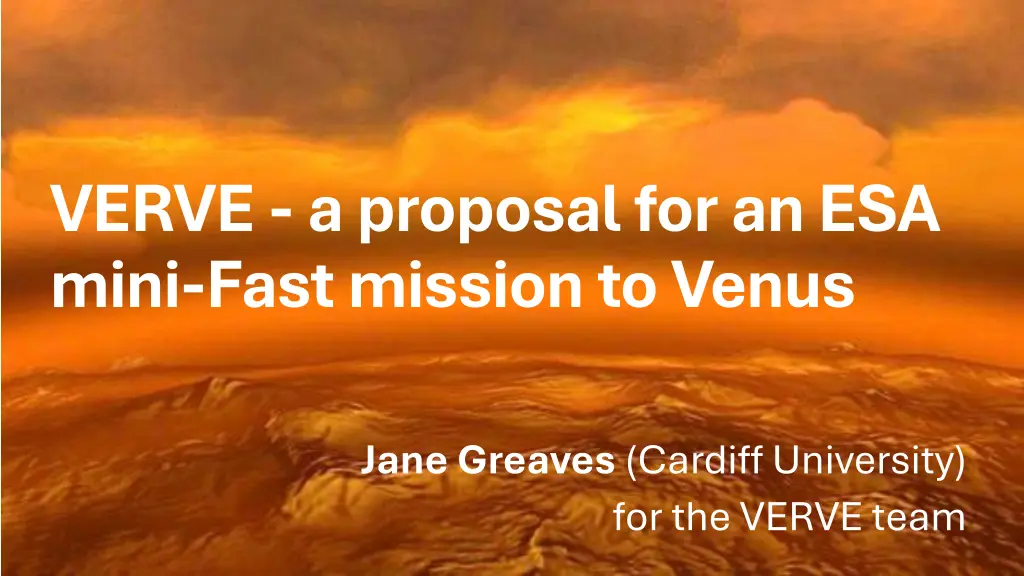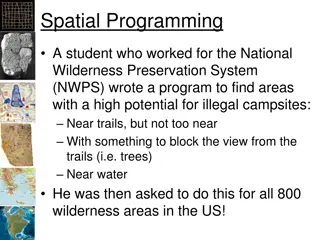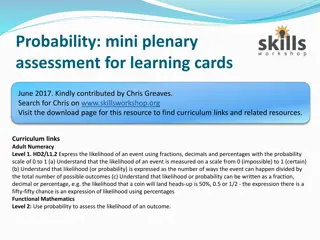
ESA Mini-Fast Mission to Venus Proposal
"Explore the innovative VERVE mission proposal for an ESA mini-Fast mission to Venus by Jane Greaves and the VERVE team. Discover the submillimeter spectrometer scanning Venus for out-of-equilibrium gases potentially linked to life, targeting gases like ammonia and phosphine. Learn why the submillimeter wavelength range is crucial for this mission and the challenges faced in power, communications, and more. Explore the mission design aiming to launch in November 2031 and arrive mid-2033, enabling unique scientific discoveries complementary to other Venus probes."
Download Presentation

Please find below an Image/Link to download the presentation.
The content on the website is provided AS IS for your information and personal use only. It may not be sold, licensed, or shared on other websites without obtaining consent from the author. If you encounter any issues during the download, it is possible that the publisher has removed the file from their server.
You are allowed to download the files provided on this website for personal or commercial use, subject to the condition that they are used lawfully. All files are the property of their respective owners.
The content on the website is provided AS IS for your information and personal use only. It may not be sold, licensed, or shared on other websites without obtaining consent from the author.
E N D
Presentation Transcript
VERVE -a proposal for an ESA mini-Fast mission to Venus Jane Greaves (Cardiff University) for the VERVE team
what is it? a submillimetre spectrometer scanning Venus for out-of-equilibrium gases one origin of which could be life
target gases GBT, SRT JCMT, ALMA ammonia, NH3 phosphine, PH3
why the submillimetre? a single band at ~520-640 GHz includes all the species of interest expecting less model-sensitive results than IR builds on legacy of ISO, Herschel for Jupiter, Saturn
how to do rapid response science? instrument: single-band version of SWI on JUICE going to Jupiter system
concept feedhorn with ~0.1o FOV, scans continuously in nadir direction auto-correlation spectrometer ( ~10 MHz), single sideband filter uncooled (Tsys ~2000 K) image: Teratech
challenges? power, comms, pointing: seem fine data rate: low radiation shielding likely OK, standard for interplanetary high temperature insulation system similar to BepiColumbo? unclear how it scales down to small spacecraft platform TBD, depends on total mass low-end estimate is ~20 kg (6-8U), similar to Mars Cube One NASA/JPL-Caltech ESA
mission design launch with Envision on Ariane 64 in November 2031, arrive mid-2033 separate before EnVision aerobraking commences, leaveing VERVE in very elliptical orbit good for scanning range of planet scales (minimum 30 pixels across Venus)
conclusions EnVision is at advanced stage VERVE can t add risk! designing VERVE for very low data- rate link through EnVision; minimal mass (comparable to uncertainty in propellant mass of EnVision) mission responding to science developments since 2020 VERVE can do unique science complements efforts at life- detection with Venus probes ??? Venus Life Finder RocketLab





